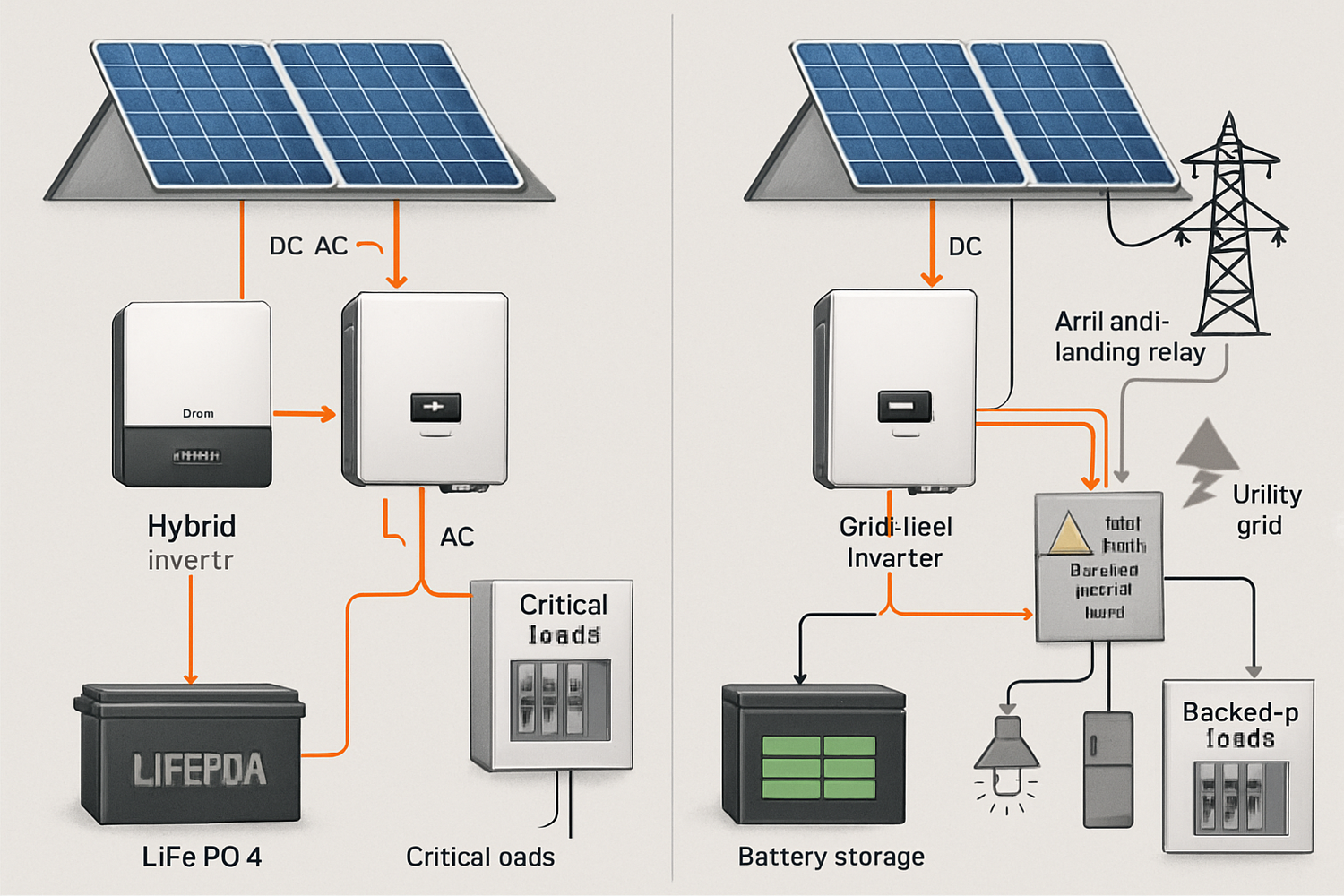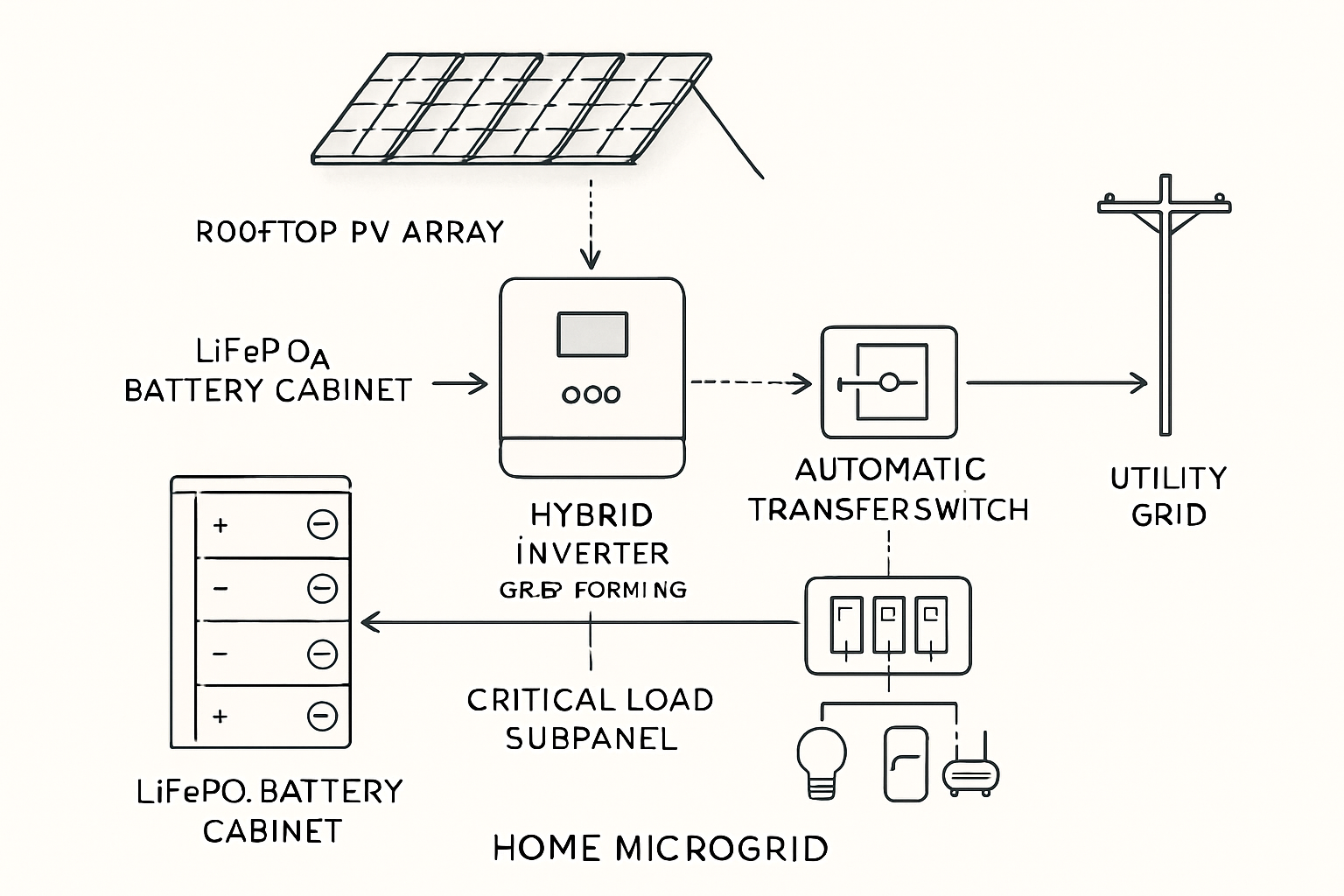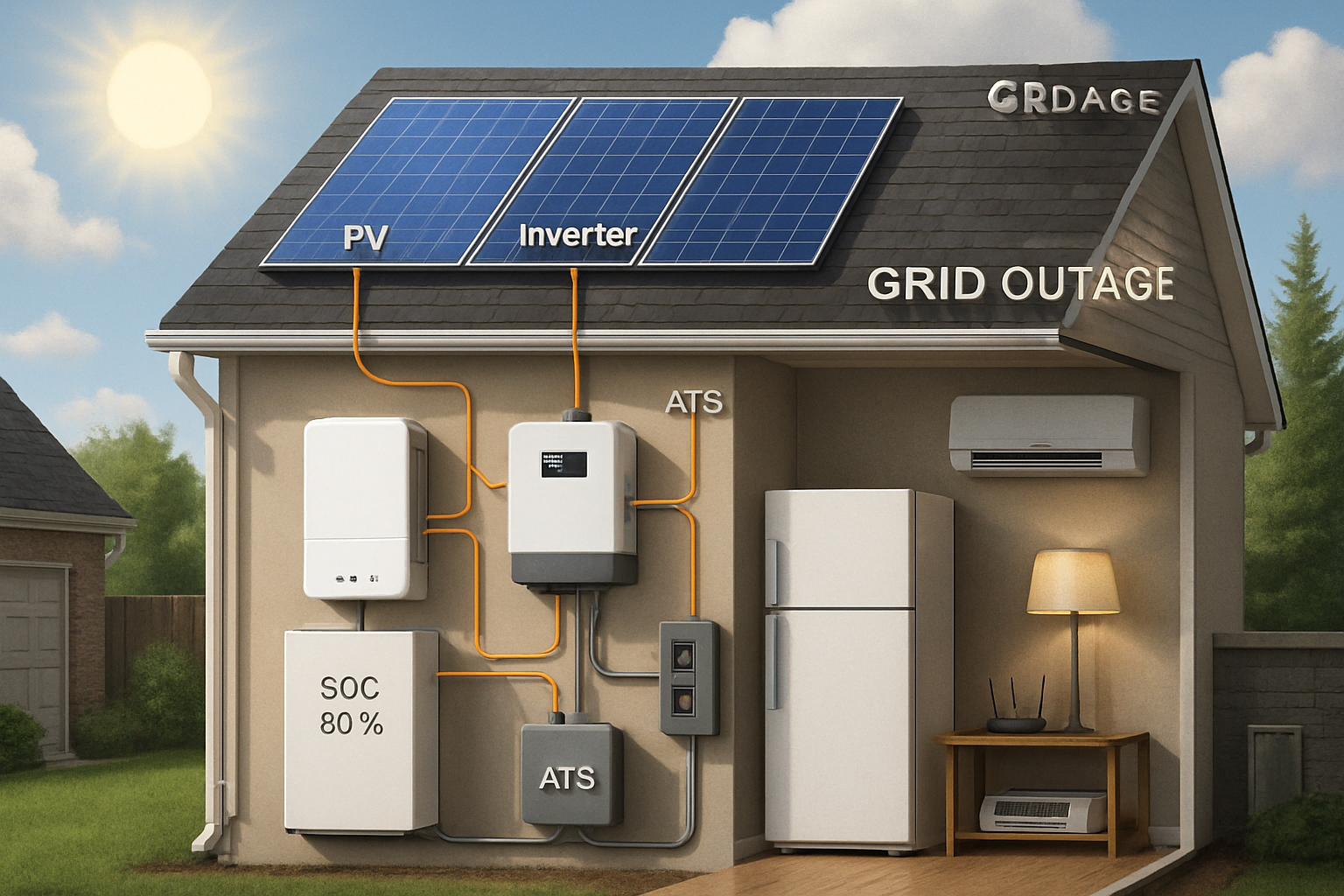Grid outages are disruptive. Many solar homeowners are surprised that a standard grid-tied system stops producing during a blackout. This piece explains why that happens, and how to design backup power with batteries, hybrid inverters, or full off-grid systems. You will see clear trade-offs, sizing tips, and practical steps to keep lights on and food fresh.

Why grid‑tied PV shuts off in blackouts
Safety is the first reason. Standard grid-following inverters must stop exporting if the grid goes down. This anti‑islanding protection prevents the PV system from energizing dead lines and protects lineworkers. PV modules produce DC power, and inverters convert it to AC synchronized to the grid. If the grid signal disappears, the inverter trips offline by design. As noted in Solar Energy Perspectives, inverters and protection devices are core parts of the balance of system, and their behavior follows grid codes.
Hybrid inverters add a different operating mode. They can form a local microgrid for your home and keep selected circuits alive. In that case, the inverter provides the AC reference and manages batteries. This grid-forming capability is a key feature discussed in Integrating Solar and Wind. The report outlines how battery energy storage systems and grid-forming inverters support stability and ride-through during disturbances.
So, a regular string inverter without batteries will shut off. A hybrid inverter with batteries can keep critical loads powered. That is the core split between grid-tied and backup-capable systems.
Three backup power paths for solar homes
Homeowners usually choose among three architectures. Each path can integrate Off-Grid Solar or Grid-Tied Solar concepts to deliver Solar Home Backup Power. Here is a concise comparison.
| Architecture | Keeps solar on during outage | Typical components | Typical usable battery | Runtime estimate for 1.5 kW critical load | Notes |
|---|---|---|---|---|---|
| Grid-tied only (no battery) | No | PV array, grid-tied inverter | None | 0 hours | Shuts off due to anti‑islanding |
| Grid-tied + battery (hybrid) | Yes, for backed-up circuits | PV array, hybrid inverter, LiFePO4 battery, critical-loads panel | 10–30 kWh common | ~7–20 hours | PV can recharge battery in daylight |
| Full off-grid solar | Yes | PV array, off-grid inverter/charger, LiFePO4 battery, generator (optional) | 20–60+ kWh common | ~13–40+ hours | Generator extends autonomy |
Runtime depends on your actual load profile, depth of discharge, temperature, and solar input. LiFePO4 batteries offer stable performance and long cycle life, which suits frequent outages and daily cycling.
Key components and how they shape backup performance
Inverters: grid-following vs grid-forming
Grid-following inverters synchronize to an external AC signal. They are efficient for net metering but provide no backup. Grid-forming inverters can establish the AC waveform for a home microgrid. During outages, they keep critical loads active and manage battery charging from PV. As covered in Integrating Solar and Wind, grid-forming assets are advancing fast and already support stability services in many projects.
Batteries: why LiFePO4 shines in homes
LiFePO4 (lithium iron phosphate) chemistry provides high cycle life, strong thermal stability, and usable depth of discharge that often reaches 80–95% depending on configuration. This gives reliable Solar energy storage solutions for homes and small businesses. A 20 kWh LiFePO4 bank with 90% usable capacity delivers about 18 kWh. With a 1.5 kW average critical load, that is roughly 12 hours of autonomy, excluding PV recharge.
PV layout and DC/AC ratio
Homeowners tend to maximize roof coverage within structural and code limits. An east‑west array can broaden the production curve. That helps self-consumption and reduces reverse power flow on local lines. The approach is discussed in Next Generation Wind and Solar Power, which notes that smart design and storage can shape load and generation profiles to ease grid impact.
Why storage boosts resilience and self‑consumption
Storage shifts daytime solar to evening peaks. It also supplies fast response during grid events. As highlighted in Getting Wind and Sun onto the Grid, storage is not mandatory for every PV system, but it adds value in many cases, especially for backup and peak shaving. With a hybrid inverter, batteries keep a critical-loads panel energized while isolating the home from the feeder. That keeps your refrigerator, lights, home office, and network gear alive.
Smart controls can also shape household consumption. Appliances may run in the solar window to charge batteries and reduce export. This aligns with the system-friendly strategies described in Next Generation Wind and Solar Power (Full Report). Electric vehicles can add flexible demand and, with the right hardware and codes, future vehicle-to-home functions can add resilience.
Sizing for reliable Solar Home Backup Power
Step 1: Define critical loads
- List essentials: refrigerator, lighting, fans or small HVAC, modem/router, phone and laptop charging, medical devices.
- Move them to a critical-loads panel. Target 1–3 kW average, with short peaks higher.
Step 2: Choose days of autonomy
- For short outages, 10–15 kWh usable storage often covers an evening and the night.
- For multi-day storms, plan 20–40+ kWh and consider a small generator as a safety net.
Step 3: Match PV to load and climate
- In many regions, a 5–10 kW rooftop array can recharge 10–30 kWh of storage on sunny days.
- Capacity factor and seasonal swings matter. The U.S. Department of Energy’s solar resources highlight regional variation and grid integration needs; see Solar Energy.
Use conservative winter production for sizing in snow or fog-prone regions. Keep DC/AC ratio in mind. Slightly higher DC can improve shoulder hour output and charging windows for batteries, within inverter and code limits. Hybrid inverters that coordinate PV, battery, and loads reduce curtailment and keep a smooth home microgrid during outages.
Real cases and field lessons
Small off-grid systems can provide meaningful services. A hands-on project installed two 250 W panels with batteries on a construction trailer to power tools and later support community work. The training project shows how battery-based solar meets real needs with modest capacity. See the U.S. Department of Energy’s story: Oglala Lakota College gets Hands-On Training for Off-Grid Solar.
At larger scale, grid-forming inverters and battery systems are improving stability and outage recovery. The trend is documented in Integrating Solar and Wind, which catalogs solutions and maturity levels for inverter-based resources and BESS. Residential systems benefit from the same control concepts. They keep frequency and voltage stable in a home microgrid and coordinate fast start of backed-up loads.
Practical checklist for homeowners
Technical must-haves for backup-capable grid-tied systems
- Hybrid (grid-forming) inverter sized for peak backed-up load.
- LiFePO4 battery bank sized for your autonomy target and charge rates.
- Critical-loads panel and transfer equipment for safe isolation.
- Surge capacity: check inverter’s 10–30 second ratings for motor starts.
- PV array wiring and protection that allow charging during outages.
Recommended settings and operating practices
- Set reserve state of charge (for example, 20–30%) to ride through night events.
- Enable time-of-use or self-consumption modes to save costs and keep batteries ready.
- Update firmware and monitoring. Many issues trace back to outdated settings.
- Test your backup mode each season. Verify that priority circuits behave as planned.
Off-grid tips
- Plan 2–3 days of autonomy where storms are frequent.
- Consider a backup generator for extended cloudy spells; integrate it with the inverter/charger.
- Use LiFePO4 batteries for long cycle life and high round-trip efficiency.
Frequently asked technical points
Why can’t a standard PV inverter just power my house during an outage?
It has no grid reference and must avoid energizing lines. Anti‑islanding is a safety requirement, implemented through detection and trip logic. The balance-of-system view and inverter roles are outlined in Solar Energy Perspectives.
Can I add batteries to an existing Grid-Tied Solar system?
Yes, with a hybrid inverter or an AC‑coupled battery inverter that can form a microgrid. The system must isolate your backed-up circuits during outages. Many designs reuse the existing array and add a critical-loads panel. Grid integration practices for distributed PV and storage are covered in Next Generation Wind and Solar Power (Full Report).
Do I need a very large battery?
Not always. Start with a right-sized bank for a 1–2 kW critical load and 8–12 hours of autonomy. Expand later. Modular LiFePO4 batteries and integrated home ESS make this easier. Storage adds resilience and improves self-consumption, a point echoed in Getting Wind and Sun onto the Grid.
How integrated ESS improves user experience
An integrated home ESS combines a hybrid inverter, LiFePO4 battery modules, and PV management. You gain fast transfer to backup mode, coordinated charging, and remote monitoring. For households with occasional outages, a 10–15 kWh setup may be enough. For rural homes, farms, and cabins, a 20–40+ kWh bank paired with a right-sized inverter provides steady off-grid living. A separate solar inverter is still vital to convert DC to AC efficiently and to meet electrical code requirements.
Policy and grid context that shape design choices
As distributed PV grows, grid operators value systems that reduce reverse flows and manage peaks. Smart appliances, storage, and EV charging strategies improve local hosting capacity. These ideas are emphasized in Next Generation Wind and Solar Power. On the broader grid, clean energy growth requires reliability and resilience. The U.S. Department of Energy’s Solar Energy resources discuss planning for adequacy, operational reliability, and recovery after extreme events. These same themes guide home system design: right-size, add storage for critical loads, and use controls that prioritize reliability.
Putting it all together
If you only need net metering savings, a standard Grid-Tied Solar setup is fine. For backup, add a hybrid inverter and storage. For full independence, go Off-Grid Solar with more storage and an optional generator. Use LiFePO4 batteries for safety and long life. Shape your array layout for a broader production curve. Keep a critical-loads panel modest to stretch runtime.
Our team builds lithium battery packs, home ESS that integrate batteries, hybrid inverters, and PV, plus off-grid solar solutions for homes, farms, and cabins. The goal is reliable and scalable energy that supports energy independence. With careful design and quality components, Solar Panel Power Outages no longer stop your daily routine.
References
- IEA. Solar Energy Perspectives. Key roles of inverters and BOS in PV systems. https://www.iea.org/reports/solar-energy-perspectives
- IEA. Next Generation Wind and Solar Power. System-friendly PV, east‑west layout, and storage for self-consumption. https://www.iea.org/reports/next-generation-wind-and-solar-power
- IEA. Next Generation Wind and Solar Power (Full Report). Distributed PV, smart controls, and storage integration. https://www.iea.org/reports/next-generation-wind-and-solar-power-full-report
- IEA. Integrating Solar and Wind. Grid-forming inverters and BESS for stability and resilience. https://www.iea.org/reports/integrating-solar-and-wind
- IEA. Getting Wind and Sun onto the Grid. Storage value and myths on backup needs. https://www.iea.org/reports/getting-wind-and-solar-onto-the-grid
- U.S. DOE. Solar Energy. Technical resources and integration topics. https://www.energy.gov/topics/solar-energy
- U.S. DOE EERE. Off-grid training project case. https://www.energy.gov/eere/success-stories/articles/eere-success-story-oglala-lakota-college-gets-hands-training-grid





Leave a comment
All comments are moderated before being published.
This site is protected by hCaptcha and the hCaptcha Privacy Policy and Terms of Service apply.